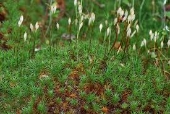

Jacke's forest garden book is a good source for temperate zone permies

Soils for successful moss propagation:
* For containers to grow moss from pulverized moss for the sole purpose of transplanting: Use builder’s sand and weed-free compost in equal parts (Schenk 98 ).
* For containers where moss sods will be transplanted (i.e. EcoRoofs): Use 1/3 acidic loam, 1/3 builder’s sand, and 1/3 humus with an additional sprinkling of medium-sized water absorbent polymer crystals (Schenk 133). Besides mixing the crystals into the soil, layer a 1/2” of hydrated crystals at the bottom of the container; this will increase the longevity of the moss by harboring it from drought (Schenk 135).
* To stimulate moss growth, treat soil with one of the following: fertilizer, egg whites mixed with water, plain milk, unsalted buttermilk, or beer (Schenk 60). When using fertilizers, make sure that there are no traces of calcium as it kills moss (Schenk 133).
* Most moss prefer soil with a pH level around 5.5. Soil can be acidified to this pH by covering the ground with any of the following, followed by a sprinkling of water to adhere particles to the soil: powered sulfur, powered skim milk, powered aluminum sulfate, or rhododendron fertilizer (Schenk 81).
* To prepare soil for moss inhabitation, keep the ground weeded and smoothly raked, as well as free of leaf liter and other debris (Schenk 85).
Methods of propagation:
* Simply transplant moss from one like area to another (Schenk 89). Plant hand-sized moss sods at spaced intervals of 1’ (30cm.), fix in place with bobby pins or flat, wooden toothpicks bent into a “v”, and wait for the moss’s growth to fill in the barren areas (Schenk 91, 115, 158). Moss should be watered daily until it has acclimated to the site. (Schenk 136)
* Take dried, collected samples of moss and pulverize them by rubbing them across a mesh screen, with openings of 1/4” – 3/8” (Schenk 156).
* Make a “moss-mud slurry” by adding 1 lb. of leaf mold, acidic garden loam or barnyard manure to a large jar and then add water until the jar is 2/3 of the way full. Cap the jar securely and shake vigorously until the contents are well mixed; allow contents to settle. Pour off the water, along with whatever’s floating in it. Scoop one cup of the slurry into a blender and blend with a pancake-sized sod of moist moss. Pour the moss-mud slurry directly onto soil or onto a brick resting in a plate of water; moss grown on the brick can be transplanted to soil later (Schenk 158).






